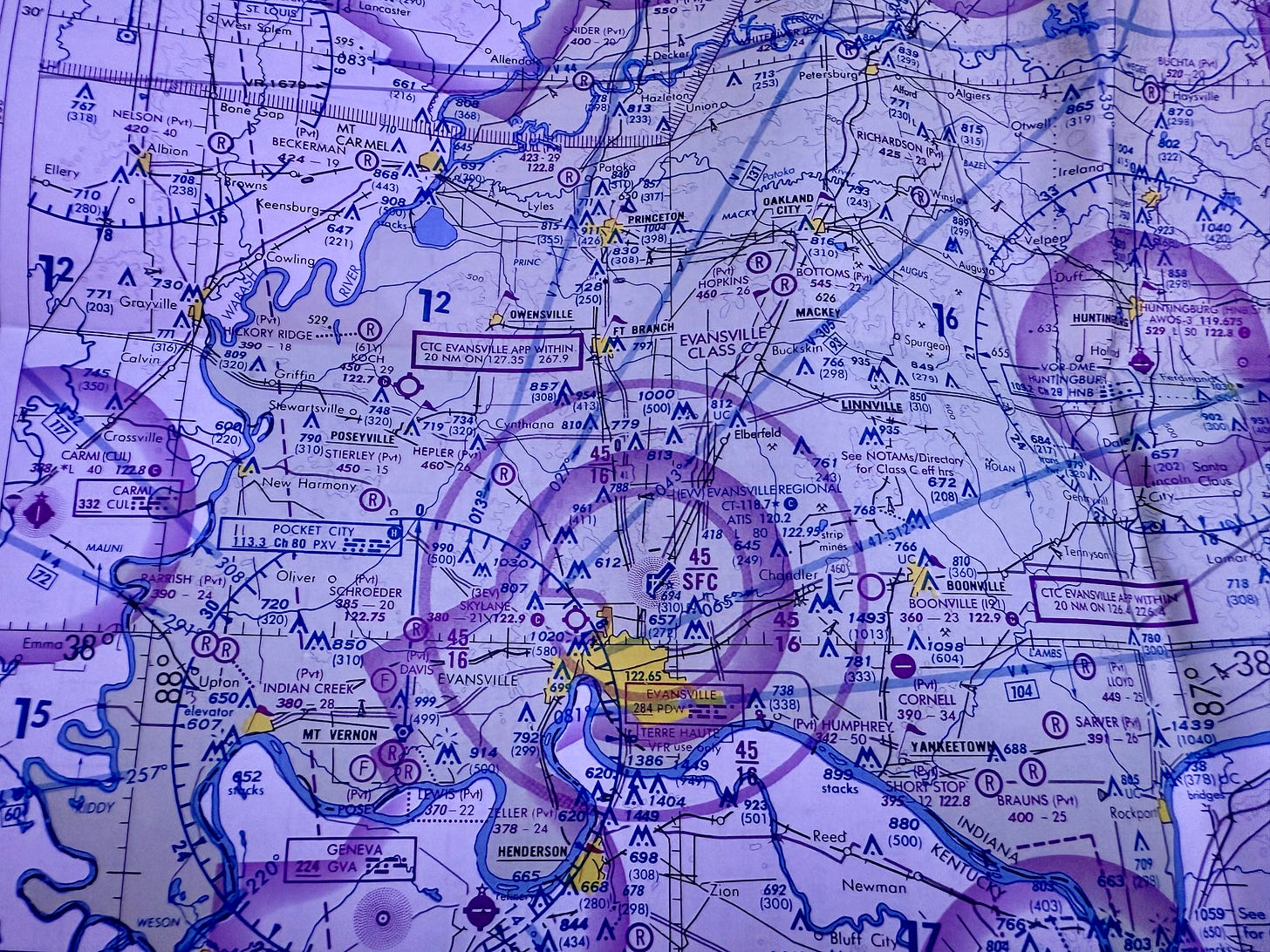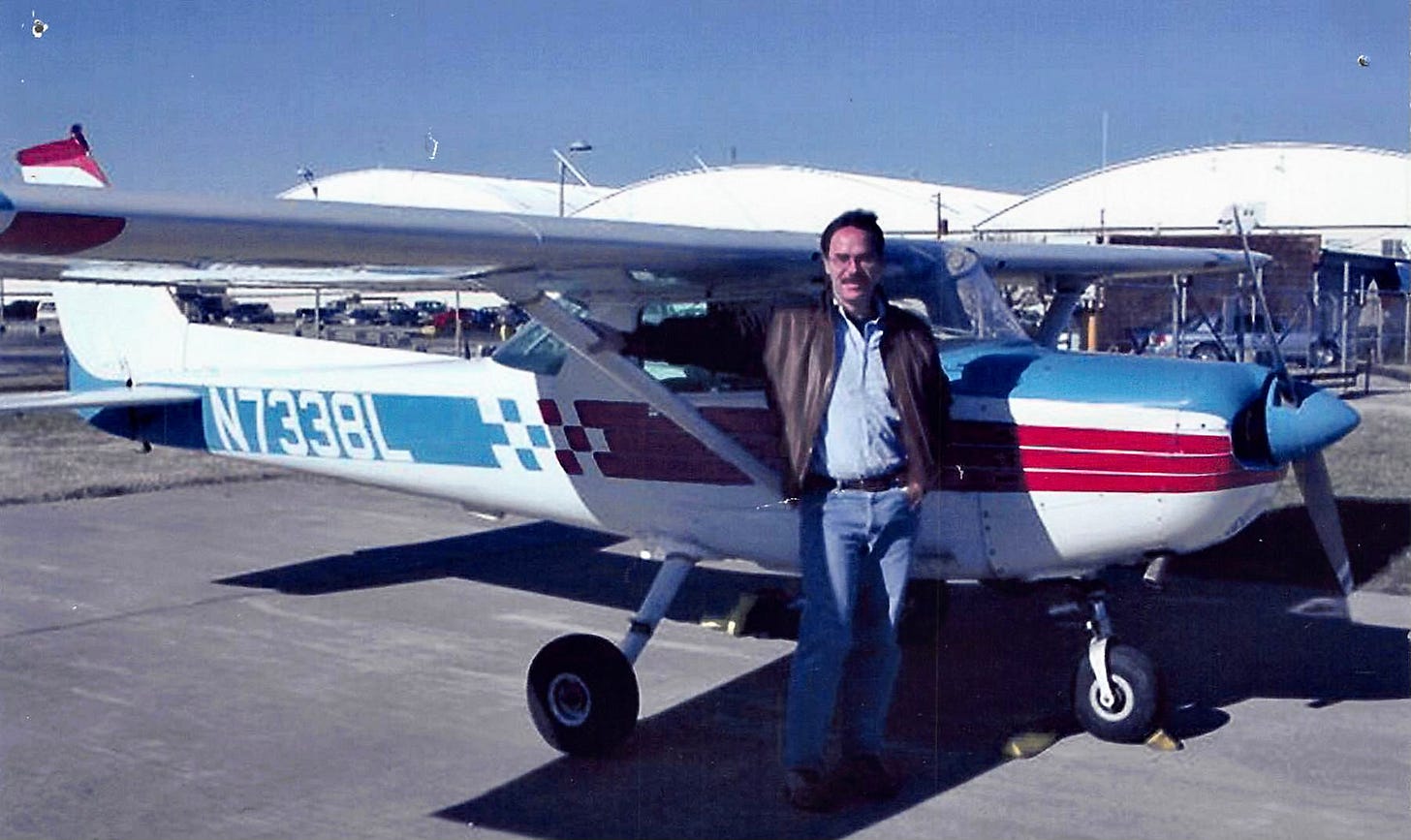Act II
A solo cross-country flight became my next challenge as I continued to refine the skills necessary to pass the flight test. I was required to organize a trip involving multiple airports, obtain weather updates, identify radio frequencies, file a flight plan, communicate with various air traffic control personnel, and navigate to each destination. The long distances between stops demanded practice in fuel management, which I calculated in advance using current weather conditions, aircraft weight, speed, and the flight plan.
Aeronautical map showing the Evansville Regional Airport near the middle with a tiny diagram of the runways.
Unlike today’s pilots, I used folded paper aeronautical charts that were cumbersome in a small cockpit. A clear plastic ruler-protractor was used to plot course headings and distances in nautical miles. Captain Cook would have recognized the method. None of this is necessary today, as digital cockpit displays use GPS to show you exactly where you are at all times.
This adventure was enjoyable, allowing me to view much of Indiana, Kentucky, and Illinois from above during several cross-country trips, both by day and at night. I was learning to navigate a complex, mostly invisible transportation system that has evolved over the past century, primarily using 1950s technology.
Night flying was a breathtaking experience, showcasing illuminated cities and expansive dark stretches of land and sky where stars shone brightly, and other traffic was easily spotted by their blinking running lights.
Cross-country flights offered freedom, beauty, peace, and meditation. Occasionally, I would become confused or lost, but I knew I could radio for help if I couldn’t figure things out on my own. My one near mishap happened in the landing pattern at Bowling Green, Kentucky, while I was working through radio instructions to locate another airplane. I lost track of my airspeed and wing angle, and I heard the dreaded stall warning squeal. Thanks to all that practice, I was able to correct the situation immediately without stalling. Stalling is not something you want to do at low altitude.
Having completed cross-country flights, my training and solo practice concentrated on the full range of skills needed to pass the flight practical test that stood between me and my private pilot certificate.
Home base. Evansville Regional Airport.
My flight practical test took place on a cold, gray, blustery, overcast December day that made me think they would have to reschedule it. As a beginner without an instrument rating, I was required to fly under “visual flight rules,” which meant I could not fly if clouds were too close or my view of the ground and other traffic was obstructed. There is very little room for error regarding the prescribed test requirements, and a 12-knot crosswind would not help. I made multiple nerve-induced trips to the restroom as I waited in the pilot’s lounge for the FAA inspector to arrive. My limbic system was in “fight or flight” mode, but it felt more like fighting flight mode. I didn’t want to get on that plane.
The FAA inspector was as grim as the weather during the oral portion, and I was on edge as I glanced at the gloom out the window. Although the conditions were marginal, with clouds below 5,000 feet, the inspector assured me he was rated for instrument flight and could get us back if needed. I nailed the oral exam, with the flash cards priming my brain with information I might retain for a few more days.
The wind was indeed a challenge, but I kept slogging through the crosswind takeoffs and landings, S turns, slow flight, level flight, emergency landing drill, navigation, and other portions of the flight test. Then came the stall drill. If I went into a spin, it would be game over for my flight test. When the stall alarm sounded, I kept the ball centered on the attitude indicator, maintained level wings, and recovered from the stall according to the book. For the instrument flying exercise, I hardly needed the hood that obscured my view of the surroundings as the weather continued to worsen.
Unlike a training flight, there was no immediate feedback on my flying, just note-taking and instructions. We finally landed in silence, taxied, and parked while he continued to make notes on his clipboard. It wasn’t until we got back in the office that he asked for my medical card and pilot logbook. With his signature, I became a licensed private pilot on December 22, 2003, almost precisely a century after the Wright brothers’ first flight.
My first flight as a licensed private pilot. It was a perfect January day, unlike the gloomy flight test day.
One problem with achieving a dream is that once the prize is in hand, you must set your next destination in the flight plan. Focused on getting my license, I failed to consider how I would use my new capability. Exploring the possibilities brought me to the brink of disaster. Notice in the photo above how far the propeller is from the ground. Imagine how far the plane would need to tip forward for the prop to strike the runway. Keep that visual in mind as you read Act III. The final installment of this story describes what was almost the final installment of my life story.
“They’ve promised that dreams can come true - but forgot to mention that nightmares are dreams, too.”
Oscar Wilde







Beautifully told.
You brought back many memories of the day I too obtained my VFR pilot’s license